Evolution has thrown up a lot of really, really strange critters over the years. One of the strangest, and certainly one of the ones to which paleontologists have applied the most effort to in figuring out is Helicoprion- the shark with a spiral of teeth.
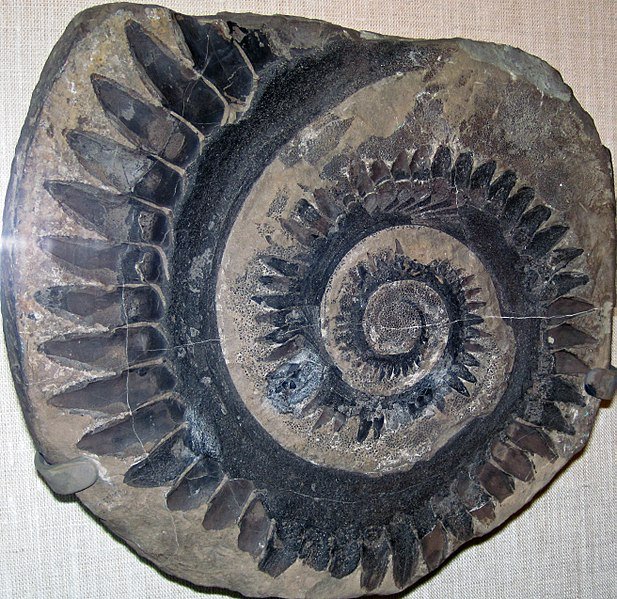
Helicoprion's famous jaw structure. [Image source]
Helicoprion wasn't strictly a shark. Instead, it was the largest of the now extinct order of Eugeneodontida, growing to over thirty feet in length. To look at it, however, it probably would have looked exactly like a shark, except for the spiral jaw structure, which could contain over 150 teeth. (And you probably wouldn't want to take a closer look at it if you were in the water.) The Eugeneodonts all had similar spiral shaped structures in their jaws- the problem was, however, that Eugenodonts were also largely cartilaginous fish. The teeth are literally the only parts of the animals we had.
This is less than a problem in some ways than you would think. We could know that they came from an oceangoing animal, given the deposits the fossils were found in. We could tell that it was likely from some sort of fish- though there were some false starts that considered them to be eels. Slowly we figured out their ancestry, eventually proving them to be distant relatives of the ratfish. Their teeth also resembled shark teeth in quite a few ways. Through the whole process, though, we had no idea where their weird jaw spiral went.
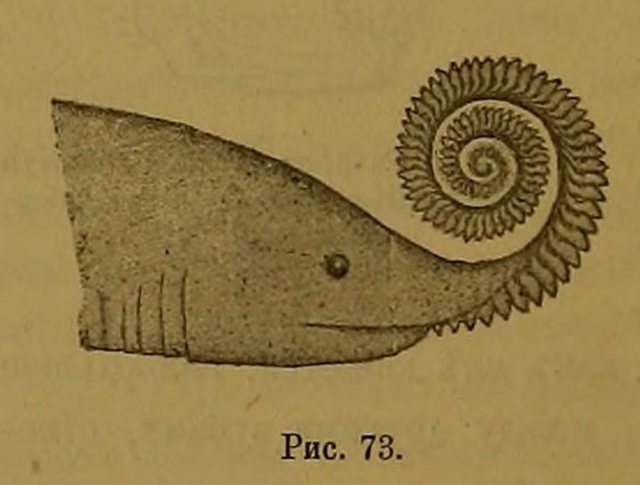
An 1899 depiction of what Helicoprion's jaw might have looked like. [Image source]
Most of the paleontologists who first worked on it usually assumed that the structure was held outside the jaw- closing the mouth with a giant spiral of teeth inside seems understandably problematic. Other believed that they weren't even teeth, and instead belonged on the tail or elsewhere on the body. Everyone who did think they were teeth also assumed that it was a structure of the upper jaw until the discovery of a related species, Ornithoprion, was shown to have its spiral in its lower jaw. In 1966, it was proven that at least some of its spiral was contained in its mouth.
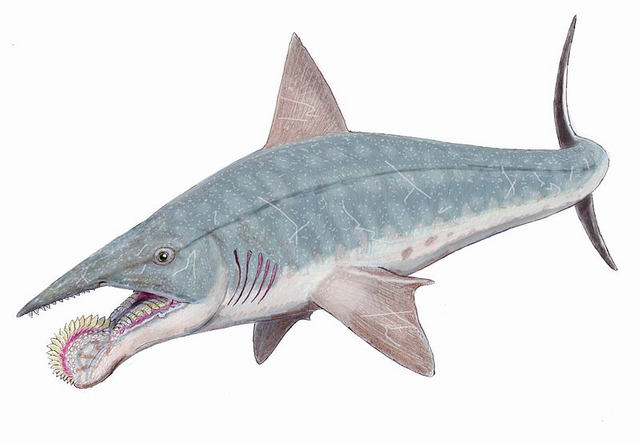
A more recent, but still outdated, reconstruction of Helicoprion. [Image source]
Helicoprion and its kin lived during the early Permian, the era before the Triassic. They were largely extinct by the time of the Permian mass extinction- the greatest mass extinction in the history of Earth- and if any survived up until the mass extinction, they didn't survive past it. They were all obligate carnivores, and likely consumed soft-bodied prey, as they lacked teeth in their upper jaw. Their prey would have been repeatedly sliced up by the tooth spiral before being eaten.
Most of the world's Helicoprion and other Eugeneodonts have been found in Montana, though the first example was found in Kazakhstan. In 2013, the debate was finally settled by a fossil found in Montana. The spiral was, in fact, largely contained within the jaw.
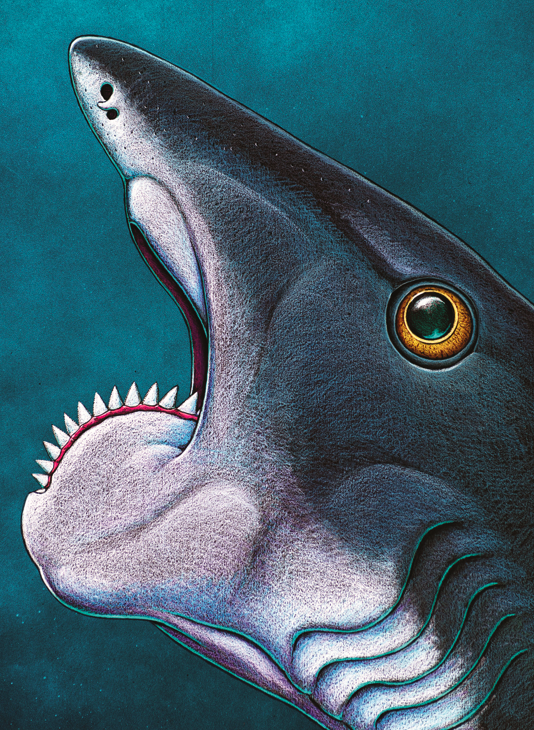
The modern conception of Helicoprion. [Image source]
Who knows, though? Maybe we'll find more fossils which change our picture of Helicoprion. We're pretty sure we've got it right at this point, but there's always just that little bit of uncertainty left. We'll certainly learn more about the other Eugenodonts, many of which had bizarre jaw structures different than Helicoprion's.
One important lesson to take away from the saga of Helicoprion is the skill which we've gained from reconstructing ancient creatures from fragmentary clues. We're at the point where given a single bone we can reconstruct many creatures from scratch. It's an incredibly detailed and specialist skill, and one I'll be going into in much greater detail in the future- but for now, you shouldn't just be marveling at nature's creativity. You should be proud at our skills in decoding nature's past.
*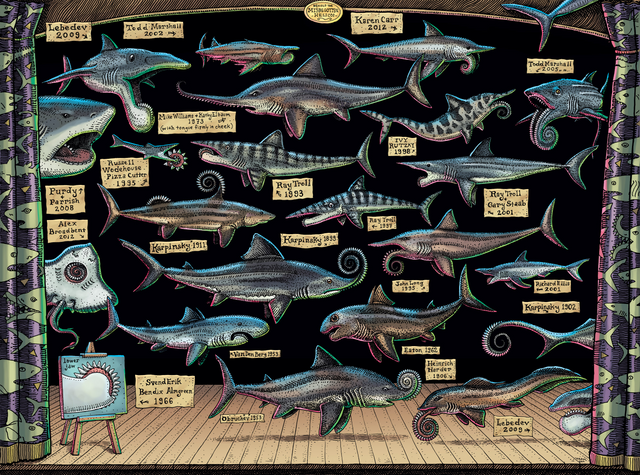
A few of the different reconstructions of Helicoprion over the years. [Image source]
If you found Helicoprion interesting, you might want to check out my post on Dunkleosteus, an armor-plated seagoing titan who lived long before Helicoprion ever showed up on the scene- which was a good thing for Helicoprion!
Bibliography:
https://en.wikipedia.org/wiki/Helicoprion
https://en.wikipedia.org/wiki/Eugeneodontida
http://phenomena.nationalgeographic.com/2013/02/26/buzzsaw-jaw-helicoprion-was-a-freaky-ratfish/
https://blogs.scientificamerican.com/running-ponies/prehistoric-ghost-shark-helicoprions-spiral-toothed-jaw-explained/
They got lucky getting that much fossil material from a shark. They got even luckier getting the connective material you mentioned - we have a FASCINATING past! Great article! related:
Downvoting a post can decrease pending rewards and make it less visible. Common reasons:
Submit
Oh wow, neat find!
Downvoting a post can decrease pending rewards and make it less visible. Common reasons:
Submit
Sure reminds me of a Ammonite with teeth
as I'm looking at a few fossils of them on my desk.
Mine don't have teeth but there are some crystals
that made me think of it :-)
I was also thinking of your name @mountainwashere!
When I lived in Calif and read about ancient Mt. Tehama
where Mt Lassen now is 🗻 . I bet you know about that one ;-)
Downvoting a post can decrease pending rewards and make it less visible. Common reasons:
Submit
I didn't, actually! I'll have to read up on that one!
Downvoting a post can decrease pending rewards and make it less visible. Common reasons:
Submit
I first read about it in the ''Roadside Geology'' books, they are
so awesome to reread and take with on the road.
Mount Tehama 4th picture from top shows
'Diamond Peak, a dacitic satellite cone of Mount Tehama', you can see a round
lava plug eye hole on the side. Long ago I got to walk to the top of Lassen.
Only made it to the parking lot on Mt Shasta ;-) Be cool to see a write up from
you in the future of those two places 🌋🗻
Downvoting a post can decrease pending rewards and make it less visible. Common reasons:
Submit
Might do! I love the roadside geology books, by the way- I've got the ones for Oregon and Washington!
Downvoting a post can decrease pending rewards and make it less visible. Common reasons:
Submit
Awesome! I got a California and Alaska
roadside geology books years ago, then recently
at a used book store picked up a extra copy of
Alaska and found a Montana roadside book.
It would be so cool to have the whole set some
day. Perhaps trade with other folks who have
more than one copy lol
Have a great day :-)
Downvoting a post can decrease pending rewards and make it less visible. Common reasons:
Submit
You too!
Downvoting a post can decrease pending rewards and make it less visible. Common reasons:
Submit
Fascinating critter. How certain are they about it not having teeth in the top jaw? I'm just thinking in terms of what other potential feeding strategies that tooth spiral could facilitate...
Downvoting a post can decrease pending rewards and make it less visible. Common reasons:
Submit
As far as I can tell, and from what I learned in my marine science classes I've had, it would have to go on the bottom jaw. This is because putting that on the top jaw would actually impair its ability to properly feed.
"its whorl's similarity in appearance to ammonoids was actually a clue: the shape made it good for snagging ammonoid flesh and then ripping them out of their shells." Link to quote
It is also important to notice the cartilage from where the attachment occured, if you put it on the top jaw that way, it would be hanging out of its mouth and not practical for feeding.
Downvoting a post can decrease pending rewards and make it less visible. Common reasons:
Submit
Ah ok, I was actually thinking of an arrangement that involved the spiral in the lower jaw and some recurved teeth in the upper, so it would act as a sort of 'shell-cracker' for armored prey. I mean I'm not sure how practical that would be but it's interesting to speculate :)
Downvoting a post can decrease pending rewards and make it less visible. Common reasons:
Submit
They found cranial tissue attached that came from the lower jaw attached to one fossil.
Downvoting a post can decrease pending rewards and make it less visible. Common reasons:
Submit
I'm dreaming about the day when the species, all that existed and those that were not included in evolution could be simulated "in-silico". I hope I will live long enough to see it.
Downvoting a post can decrease pending rewards and make it less visible. Common reasons:
Submit
That would certainly be interesting! Of course, there are quite a few I'm not sure I'd like to meet.
Downvoting a post can decrease pending rewards and make it less visible. Common reasons:
Submit
@originalworks
Downvoting a post can decrease pending rewards and make it less visible. Common reasons:
Submit
The @OriginalWorks bot has determined this post by @mountainwashere to be original material and upvoted it!
To call @OriginalWorks, simply reply to any post with @originalworks or !originalworks in your message!
Downvoting a post can decrease pending rewards and make it less visible. Common reasons:
Submit
remarkable work
Downvoting a post can decrease pending rewards and make it less visible. Common reasons:
Submit
What a remarkably fast response. What did you find remarkable about it?
In all honesty, your comment felt a lot like spam. To keep it from feeling like spam, try and comment on what the article was about, using more than just a couple of words. It's more likely to earn you upvotes and goodwill. Plus, there are a lot of people on Steemit who don't have as much patience with suspected spammers as I do, and they'll simply flag your account into oblivion.
Downvoting a post can decrease pending rewards and make it less visible. Common reasons:
Submit
Downvoting a post can decrease pending rewards and make it less visible. Common reasons:
Submit
Your Post Has Been Featured on @Resteemable!
Feature any Steemit post using resteemit.com!
How It Works:
1. Take Any Steemit URL
2. Erase
https://3. Type
reGet Featured Instantly – Featured Posts are voted every 2.4hrs
Join the Curation Team Here
Downvoting a post can decrease pending rewards and make it less visible. Common reasons:
Submit
Great topic! Come visit my channel if you are into treveling and mountaniering... One love!
Downvoting a post can decrease pending rewards and make it less visible. Common reasons:
Submit